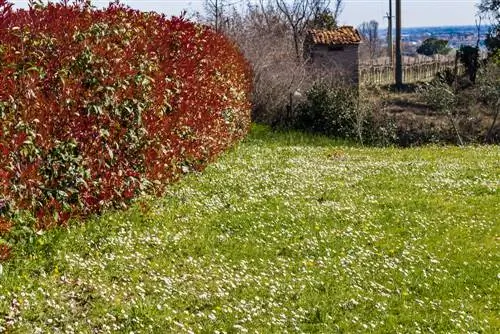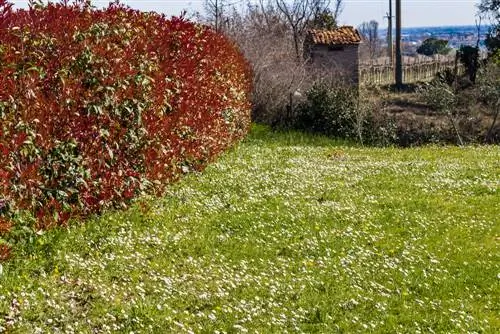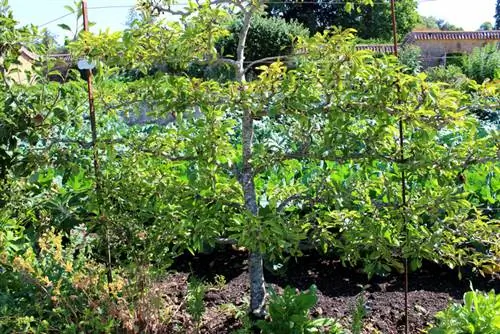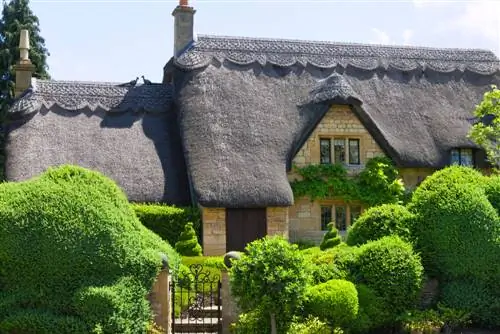- Author admin [email protected].
- Public 2023-12-16 16:46.
- Last modified 2025-01-23 11:21.
Loquats have become an integral part of many gardens. The variety 'Red Robin' is particularly popular because of its properties, but there are numerous varieties with individual advantages and diverse uses.

How do you design a loquat hedge?
A loquat hedge offers privacy with its evergreen foliage and scores with attractive red leaf shoots. The 'Red Robin' variety is particularly suitable for hedges because it is densely branched and tolerates pruning. Two plants per meter are sufficient.
The genus
The loquats represent a genus with the Latin name Photinia. The genus name is derived from the Greek word “photeinos”, which refers to the shiny leaves. They belong to the rose family and contain around 66 species, whose original distribution area is in Asia and North America. Here they grow in the warm parts of the mountainous regions. Most species within the genus are evergreen shrubs that retain their leaves in winter. When the new growth period begins in spring, the species produce fresh leaves.
Loquats are closely related to hawthorn, firethorn or cotoneasters. There is a family connection to the apple trees. What all species have in common is that they produce pome fruits. The fruits of the loquat are reminiscent of miniature apple shapes. They consist of the fleshy, thickened flower axis, which grows with the carpels. The fruits turn red or blue when ripe and remain on the bush until winter.
Breeding forms
The evergreen shrubs include the red-leaved loquat (Photinia × fraseri), which is also known as Fraser's loquat. This loquat is the result of crossing the Japanese loquat (Photinia glabra) and the saw-leaved loquat (Photinia serratifolia). The history of this variety dates back to 1943, when it was discovered in an American nursery in Alabama and spread throughout the world. Since then, various varieties have been bred from this hybrid.
Varieties of the red-leaved loquat:
- Popular varieties: 'Red Robin' and 'Little Red Robin'
- Frost-tolerant varieties: 'Camilvy' and 'Robusta Compacta'
- Special features: 'Indian Princess', 'Birmingham', 'Pink Marble' and 'Curly Fantasy'
Popular varieties
The 'Red Robin' variety is considered a popular ornamental shrub, which is colloquially known as the loquat. While this variety reaches heights of up to two meters, 'Little Red Robin' forms lower bushes. The variety grows 120 centimeters high and 120 centimeters wide. It is characterized by good pruning tolerance and is suitable for planting in containers. Two plants per meter are enough to create a dense hedge.
Frost-tolerant varieties
The 'Camilvy' variety is an improved breeding form whose leaf shoots are more intensely red than the fresh leaves of 'Red Robin'. The growth of this variety is strong and well branched. The branches grow loosely and broadly. Their growth per year is 50 centimeters. It reaches heights of up to 300 centimeters and is frost hardy down to temperatures of -23 degrees Celsius. It sprouts again after winter. Particularly prolonged subzero temperatures over several months can cause damage to the plant.
The variety 'Robusta Compacta' is a small-growing form that is well hardy. It reaches heights of between 120 and 180 meters and can reach heights of over two meters if the site conditions are good. It produces finer leaves than 'Red Robin' and has a lower growth rate per year compared to this popular variety. Their compact growth makes them ideal trees for planting in pots that decorate terraces and balconies.
Special features
'Indian Princess' is one of the compact varieties. 'Birmingham' produces sturdy leaves that have a leathery feel. 'Pink Marble' is suitable as a solitary tree because it develops tricolor foliage with pink, white and green shades. The growth habit of the leaves of 'Curly Fantasy' is striking. They are developed in a wave shape and coarsely toothed at the edge.
Usage
The leaves that sprout fresh in spring are dark red in color and form an aesthetic contrast to the dark green, shiny leaves of previous years. The leaves retain their bright red color for up to four months before turning green. Loquats can be planted alone or combined with other shrubs such as cherry laurel, jasmine or forsythia. Cultivation as a container plant is possible.
Many varieties have a high growth rate, which is why they are well suited for hedge design. After two to three years, 'Red Robin' forms a compact hedge with opaque branches. You can promote branch formation through regular pruning. The evergreen branches are a popular Christmas decoration for wreaths and bouquets.
Claims
The evergreen species prefer a partially shaded location. Although they thrive in sunny places, direct sunlight often causes leaf damage. Evaporation increases, resulting in greater water requirements. A lack of water results in drought stress, which manifests itself in the form of brown leaves. It is important for the evergreen plants to have a location protected from the wind, as dry and hot summer winds can also lead to increased water loss.
The shrubs like a permeable substrate because they are sensitive to waterlogging. The soil should be moderately dry and rich in nutrients. The pH value plays a minor role because the loquats are adaptable.
Prefer deciduous shrubs:
- a permeable substrate
- nutritious soil
- a sunny to partially shaded location






